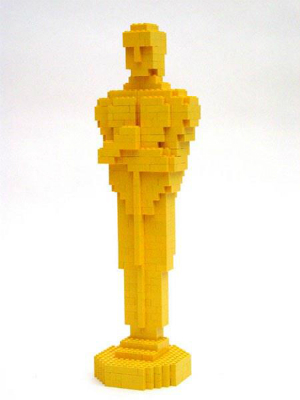The Lego Movie Is a Victim of Our Blinkered, Dumbass Disney Prejudice in Animation
 |
| Philip Lord |
Lego Movie codirector Phil Lord’s response to the Oscar snub for Best Animated Film was perfect: he Tweeted the above image with the caption “It’s okay. Made my own!“
My first reaction was to argue with colleagues of mine to whom I had to reiterate my many arguments about how the live-action scenes were integral to the theme, the characters were more feminist in realization than in so many other movies, and why it was just generally brilliant in every way.
But there’s something more insidious at work, I think, than just a difference in tastes, and it’s the same thing that allows the mainstream to keep thinking that Pokemon represents all anime, or that Ralph Bakshi movies aren’t worth talking about. As much as all of you know that animation can do just about anything, and tell every kind of story, to the older generations that make up awards voting bodies, they are “just” cartoons. And the model for what those should be is the Disney fairy tale.
My father told me growing up that animation at best should bring to life things that don’t live, and second-best, should give humanity to animals or fantasized human-types like dwarves…but it should never depict actual humans. He was thinking specifically of the finale of The Jungle Book, where Mowgli leaves all his interesting animal pals behind to go meet a generically drawn girl. Yes, it’s the lamest part of that movie, but it doesn’t invalidate, let’s say, the adventures of Tetsuo and Kaneda.
Take a look at the “independent,” “different” movies that made the Oscar cut for animated feature. I love both Song of the Sea and Princess Kaguya, but both are classic fairy-tale princess archetypes, about the magic heiress who must choose between the fantasy world and the love of a common, mortal family. They play so differently because they have strong doses of local color in both style and execution, but in the end, they are Cinderella, or Frozen, or Brave – that archetype we know so well.
In the voting organization I am part of, it seems that EVERY year, the self-appointed animation experts stump for the Disney or Studio Ghibli movie, with many following that lead. When Don Hertzfeldt’s masterpiece It’s Such a Beautiful Day was in contention, one of the arguments against it was that the animation featured stick figures instead of realistic human drawings, as if technical aspects would count against any other movie in any other category – you might as well say The Phantom Menace is a better movie than Clerks because it looks a shit-ton better.
The Boxtrolls, by the way, does genuinely push the envelope just a little bit, but I suspect much of its love is for the craftsmanship of making all the objects. The exact same story in full CG would most likely not be considered. As for How to Train Your Dragon 2, I really do like the fact that it shows a handicapped/amputee kid as a hero; it’s good for children not to be afraid of physical differences like that. But it is still a fairy tale about dragons, and as such an acceptable cartoon. Likewise, I enjoy Big Hero 6‘s diverse character lineup and nerd-friendly theme, but for a Marvel movie not beholden to Marvel Studios, the fact that it takes even fewer story risks than the main canon is a bummer.
The Lego Movie is ostensibly a hero’s journey – though, as I have said elsewhere, it is more accurately the journey of a boys perception of his father – but it’s no fairy tale. Nobody is magic, there is no princess to rescue (the only princess on hand, Unikitty, rescues the hero by being a bitch in the best way), and the characters do not live happily ever after; in fact, an eternally frozen-in-place “happily ever after” is the primary threat. The moral of the story is to think outside the box and the instructions, and frankly, it’s a lesson the goddamn Academy needs to learn when it comes to cartoons.
As evidenced by today.
